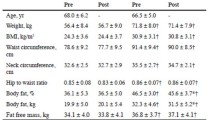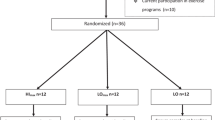Abstract
Background
Insulin-like growth factor-1 (IGF-1) is related to the preservation of lean body mass. Its decline during ageing is thought to make old adults more susceptible to sarcopenia and functional dependency. The aim of the present study was to investigate circulating total IGF-1 in old adults who engaged in a 12-weeks of progressive resistance training.
Design
Intervention study.
Setting
Community.
Participants
Old Icelandic adults (N = 235, 73.7 ± 5.7 years, 58.2% female). Intervention: Twelve-week resistance exercise program (3 times/week; 3 sets, 6-8 repetitions at 75-80% of the 1-repetition maximum) designed to increase strength and muscle mass of major muscle groups.
Measurements
IGF-1.
Results
At baseline IGF-1 was significantly associated with lean body mass and appendicular muscle mass (also when corrected for age, gender and various covariates). After the training IGF-1 decreased significantly from 112.1 ± 35.6 to 106.1 ± 35.2 µg/L during the course of the study. On and individual level, IGF-1 decreased in 59% and increased in 39% of the participants. Changes in IGF-1 were inversely related to changes in lean body mass (rho = -0.176, P = 0.013 ) and appendicular muscle mass (rho = −0.162, P = 0.019) also when corrected for protein intake, age, gender, and other covariates.
Conclusion
Serum total IGF-1 decreases after 12 weeks of resistance exercise in community dwelling old adults. When looked at IGF-1 changes for participants individually it becomes clear that IGF-1 response to resistances exercise is highly variable. Changes in IGF-1 are negatively related to changes in lean body mass during training, which supports the hypothesis that IGF-1 is redistributed from circulation into tissue during periods of active muscle building.
Similar content being viewed by others
References
Fried LP, Tangen CM, Walston J, Newman AB, Hirsch C, Gottdiener J, et al. Pisciottano MV, Pinto SS, Szejnfeld VL, Castro CH. The relationship between lean mass, muscle strength and physical ability in independent healthy elderly women from the community. J Nutr Health Aging 2014;18:554–558.
Gibney J, Healy M-L, Sönksen PH. The growth hormone/insulin-like growth factor-axis in exercise and sport. Endocr Rev 2007;28:603–624.
Velloso CP. Regulation of muscle mass by growth hormone and IGF-1. Br J Pharmacol 2008;154:557–568.
Kalyani RR, Tra Y, Egan JM, Ferrucci L, Brancati F. Hyperglycemia is Associated with Relatively Lower Lean Body Mass in Older Adults. J Nutr Health Aging 2014;18:737–743.
Nindl BC, Alemany JA, Tuckow AP, Rarick KR, Staab JS, Kraemer WJ, Maresh CM, Spiering BA, Hatfield DL, Flyvbjerg A, Frystyk J. Circulating bioactive and immunoreactive IGF-1 remain stable in women despite physical fitness improvements after 8 weeks of resistance, aerobic and combined exercise training. Journal of Applied Physiology 2010;109:112–120.
Mohan S, Baylink D. IGF-binding proteins are multifunctional and act via IGF-1 dependent and–independent mechanisms. J Endocrinol 2002;175:19–31.
Lang T, Streeper T, Cawthon P, Baldwin K, Taaffe DR, Harris TB. Sarcopenia: etiology, clinical consequences, intervention, and assessment. Osteoporos Int 2010;21:543–559.
Juul A, Scheike T, Davidsen M, Gyllenborg J, Jorgensen T. Low serum insulin-like growth factor I is associated with increased risk of ischemic heart disease:a population-based case-control study. Circulation 2002;106:939–944.
Rosendahl L, Langberg H, Flyvbjerg A, Frystyk J, Orskov H, Kjær M. Physical capacity influences the response of insulin-like growth factor and its binding proteins to training. Journal of Applied Physiology 2002;93:1669–1675.
Brugts MP, van Beld W, Hofland LJ, van der Wansem K, van Koetsveld PM, Frystyk J, Lambert SWJ, Janssen JAMJL. Low circulating insulin-like growth factor-I bioactivity in elderly men is associated with increased mortality. J Clin Endocrinol Metab 2008;93:2515–2522.
Khandwala HM, McCutcheon IE, Flyvbjerg A, Friend KE. The effects of insulin-like growth factors on tumorigenesis and neoplastic growth. Endocr Rev 2000;21:215–244.
Nindl BC, Headley SA, Tuckow AP, Pandorf CE, Diamandi A, Khosravi MJ, Welles R, Jones M, Germain M. IGF-I system responses during 12 weeks of resistance training in end-stage renal disease patients. Growth Hormone & IGF Research 2004;14:245–250.
Schmitz KH, Ahmed RL, Yee D. Effects of a 9-month strength training intervention on insulin, insulin-like growth factor (IGF)-I, IGF-binding protein (IGFBP)-1, and IGFBP-3 in 30-50-year-old women. Cancer, Epidemiology Biomarkers and Prevention 2002;11:1597–1604.
Vale RGdS, de Oliveira RD, Pernambuco CS, de Meneses SF, Novaes JdS, de Andrade AdFD. Effects of muscle strength and aerobic training on basal serum levels of IGF-1 and cortisol in elderly women. Archives of Gerontology and Geriatrics 2009;49:343–347.
Borst SE, De Hoyos DV, Garzarella L, Vincent K, Pollock BH, Lowenthal DT, Pollock ML. Effects of resistance training on insulin-like growth factor-I and IGF-1 binding proteins. Med Sci Sports Exerc 2001;33 (4):648–653.
Ballard TL, Clapper JA, Specker BL, Binkley TL, Vukovich MD. Effect of supplementation during a 6-mo strength and conditioning program on insulin-like growth factor I and markers of bone turnover in young adults. Am J Clin Nutr 2005;81:1442–1448.
McCall GE, Byrnes WC, Fleck SJ, Dickinson A, Kraemer WJ. Acute and chronic hormonal responses to resistance training designed to promote muscle hypertrophy. Can J Appl Physiol 1999;24:96–107.
Bermon S, Ferrari P, Bernard P, Altare S, Dolisi C. Responses of total and free insulin-like growth factor-I and insulin-like growth factor binding protein-3 after resistance exercise and training in elderly subjects. Acta Physiol Scand 1999;165:51–56.
Nicklas et al. Testosterone, growth hormone and IGF-1 responses to acute and chronic resistive exercise in men aged 55-70 years. International Journal of Sports Medicine 1995;16:445–450.
Moghadasi et al. The effect of 12 weeks of resistance training on hormones of bone formation in young sedentary women. Eur J Appl Physiol 2013;113:25–32.
Arnarson A, Geirsdottir OG, Ramel A, Briem K, Jonsson PV, Thorsdottir I. Effects of whey proteins and carbohydrates on the efficacy of resistance training in elderly people:double blind, randomised controlled trial. European Journal of Clinical Nutrition 2013;67:821–826.
Ainsworth BE, Haskell WL, Whitt MC, Irwin ML, Swartz AM, Strath SJ, O’Brien WL, Bassett DR Jr, Schmitz KH, Emplaincourt PO, Jacobs DR Jr, Leon AS. Compendium of physical activities:an update of activity codes and MET intensities. Med Sci Sports Exerc 2000;32:s498-s504.
American Thoracic Society Statement. Guidelines for the Six-Minute Walk Test. Am J Respir Crit Care Med 2002;166:111–117.
Eliakim A, Brasel JA, Mohan S, Wong WLT, Cooper DM. Increased physical activity and the growth hormone-IGF-I axis in adolescent males. American Physiological Society American Journal of Physiology - Regulatory, Integrative and Comparative Physiology 1998;275:R308-R314.
Gregory SM, Headley SA, Germain M, Flyvbjerg A, Frystyk J, Coughlin MA, Milch CM, Sullivan S, Nindl BC. Lack of circulating bioactive and immunoreactive IGF-1 changes despite improved fitness in chronic kidney disease patients following 48 weeks of physical training. Growth Hormone & IGF-1 Research 2011;21:51–56.
Koziris LP, Hickson RC, Chatterton RT, Groseth RT, Christie JM, Goldflies DG, and Unterman TG. Serum levels of total and free IGF-1 and IGFBP-3 are increased and maintained in long-term training. J Appl Physiol 1999;86:1436–1442.
Savastano S, Di Somma C, Barrea L, Colao A. The complex relationship between obesity and the somatropic axis: The long and winding road. Growth Horm IGF Res. pii: 2014;S1096-6374(14)00091-4.
Nemet D, Connolly PH, Pontello-Pescatello AM, Rose-Gottron C, Larson JK, Galassetti P, Cooper DM. Negative energy balance plays a major role in the IGF-1 response to exercise training. J Appl Physiol 2004;96:276–282.
Katz LEL, DeLeon DD, Zhao H, Jawad AF. Free and total insulin-like growth factor (IGF)-I levels decline during fasting:relationships with insulin and IGF-binding protein-1. J Clin Endocrinol Metab 2002;87:2978–2983.
Thissen J, Ketelslegers J, Underwood L. Nutritional regulation of the insulin-like growth factors. Endocr Rev 1994;15:80–101.
Alemany JA, Nindl BC, Kellogg MD, Tharion WJ, Young AJ, Montain SJ. Effects of dietary protein content on IGF-1, testosterone, and body composition during 8 days of severe energy deficit and arduous physical activity. J Appl Physiol 2008;105:58–64.
Ormsbee M, Clapper JA, Clapper J, Vukovich MD. Moderate changes in energy balance combined with exercise do not alter insulin-like growth factor I or insulin-like growth factor binding protein 3. Nutrition Research 2006;26:467–473.
Frystyk J. Exercise and the growth hormone-insulin-like growth factor axis. Med Sci Sports Exerc 2010;42:58–66.
Yakar S, Rosen CJ, Bouxsein ML, Sun H, Mejia W, Kawashima Y, Wu Y et al. Serum complexes of insulin-like growth factor-1 modulate skeletal integrity and carbohydrate metabolism. FASEB J 2009;23 (3):709–719.
Author information
Authors and Affiliations
Corresponding author
Rights and permissions
About this article
Cite this article
Arnarson, A., Geirsdottir, O.G., Ramel, A. et al. Insulin-like growth factor-1 and resistance exercise in community dwelling old adults. J Nutr Health Aging 19, 856–860 (2015). https://doi.org/10.1007/s12603-015-0547-3
Received:
Accepted:
Published:
Issue Date:
DOI: https://doi.org/10.1007/s12603-015-0547-3




